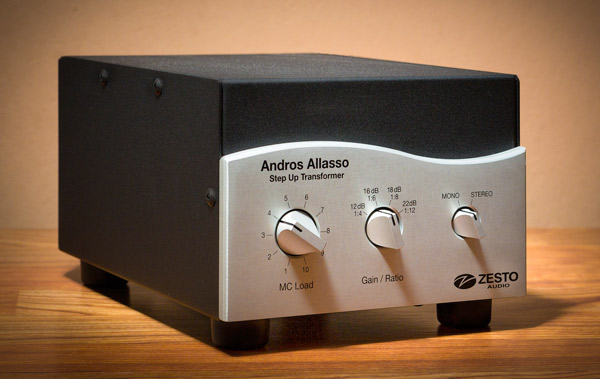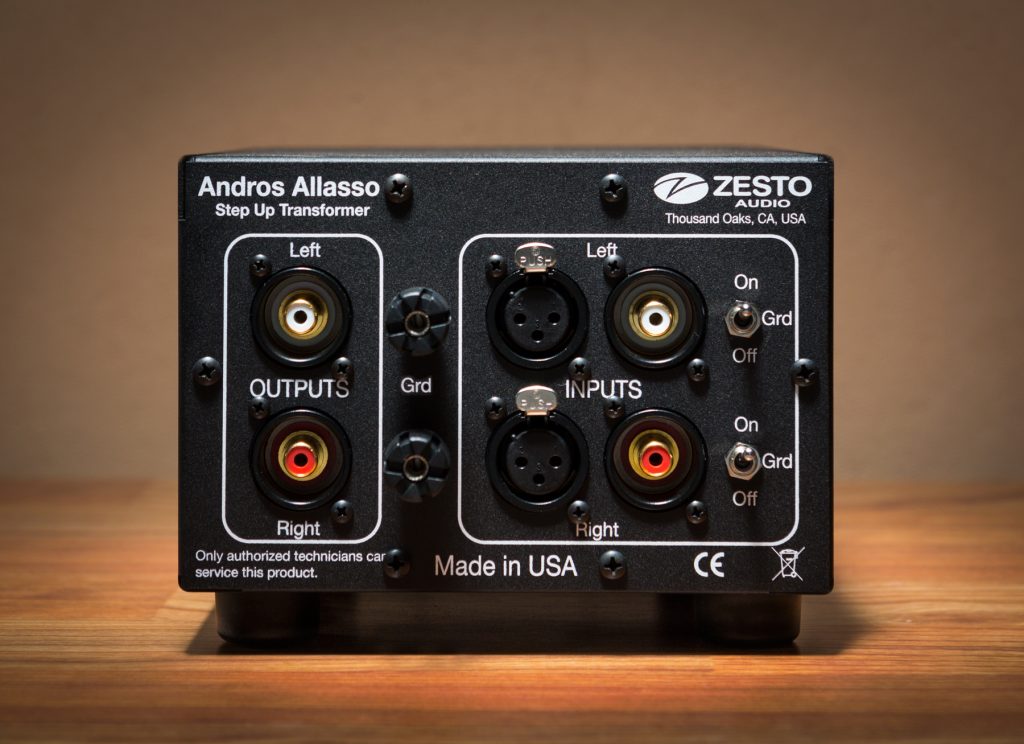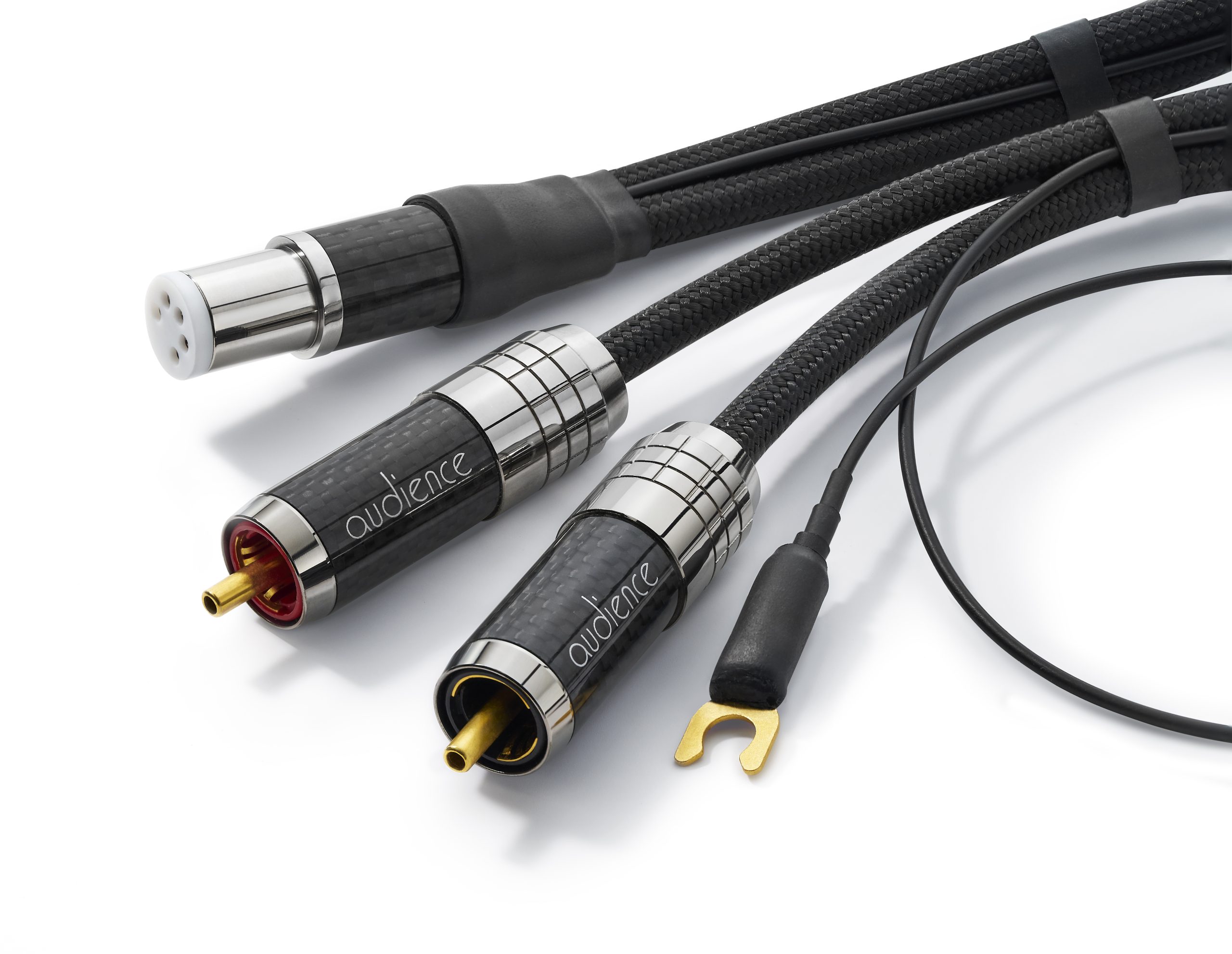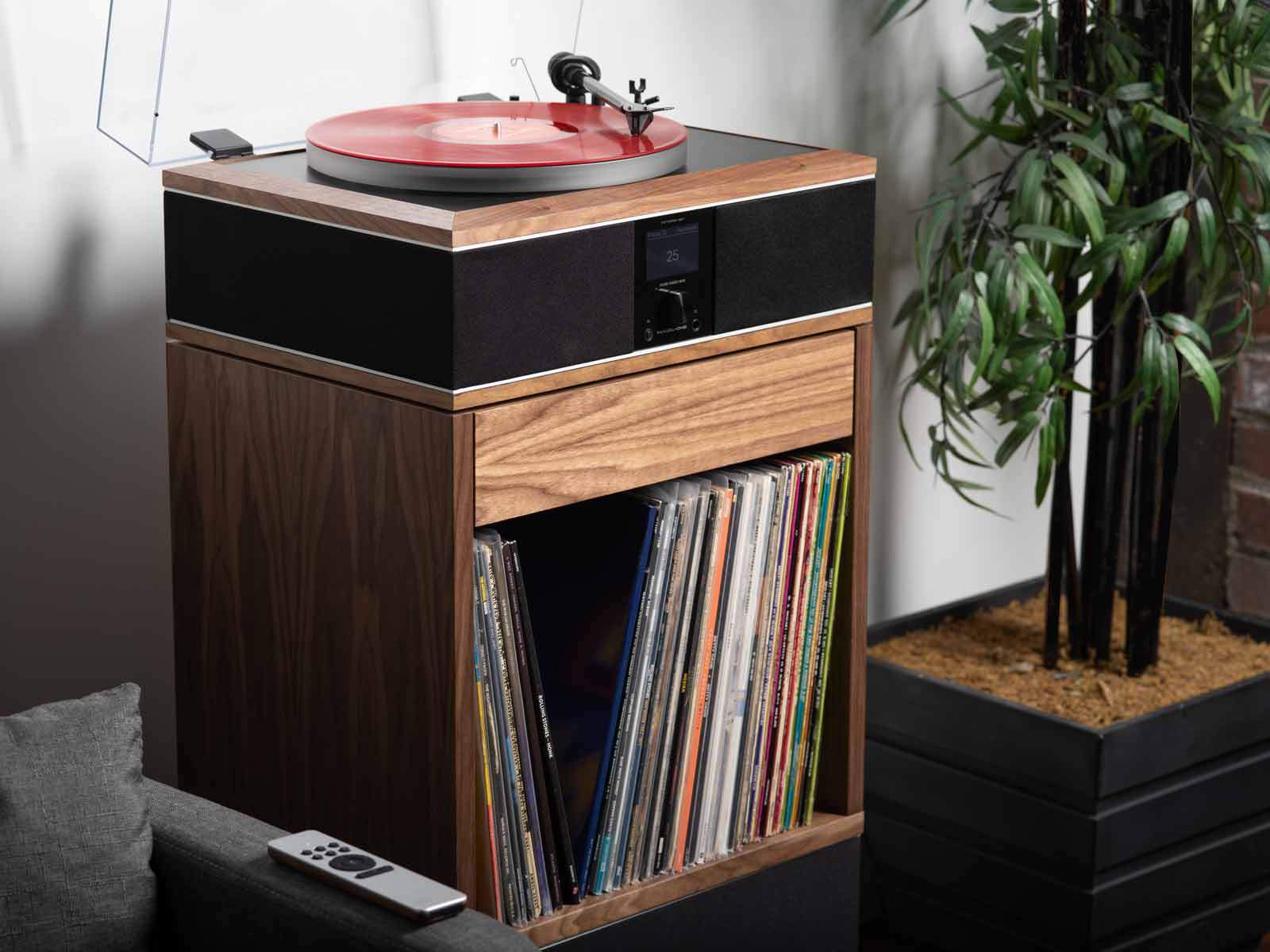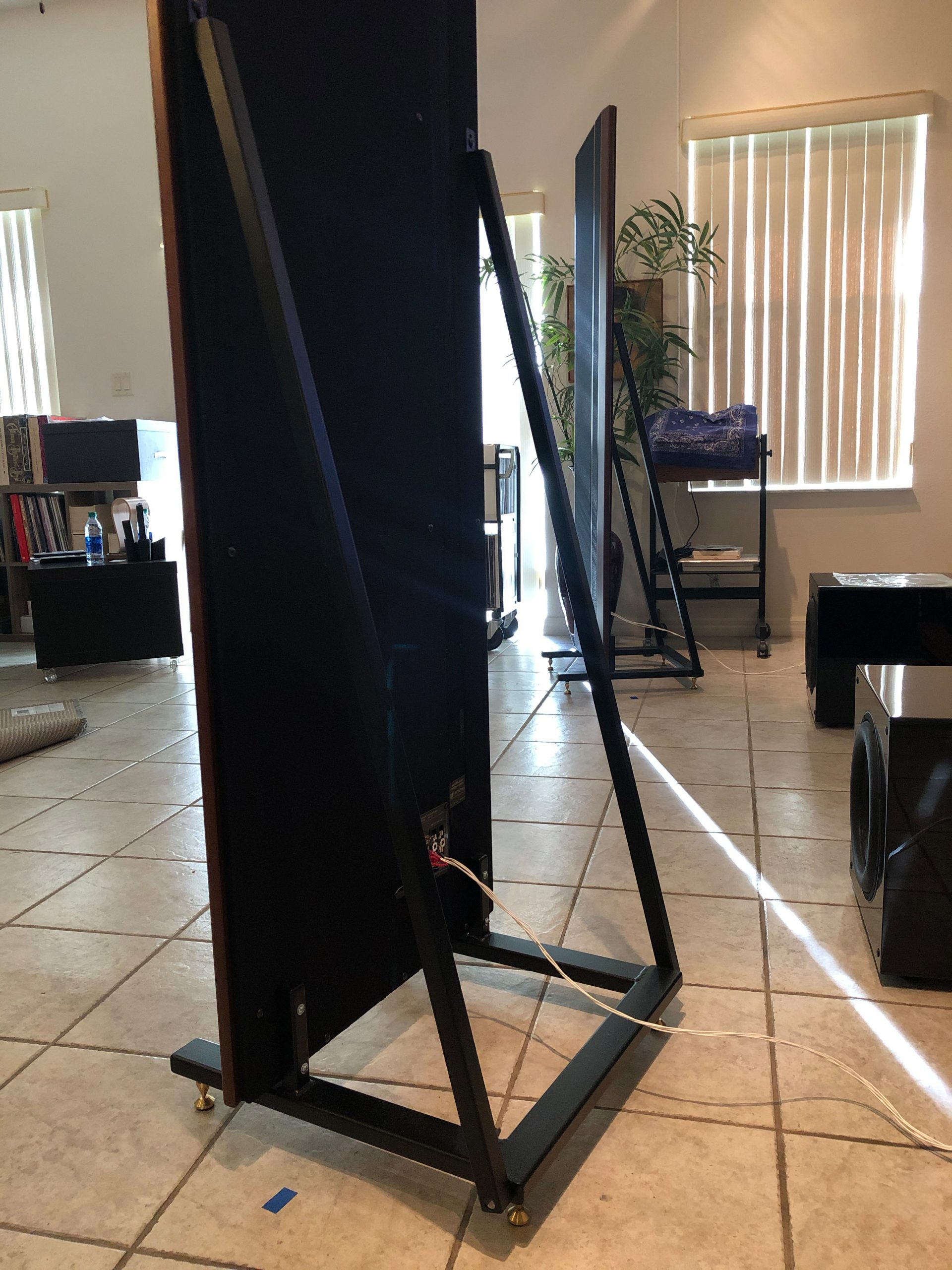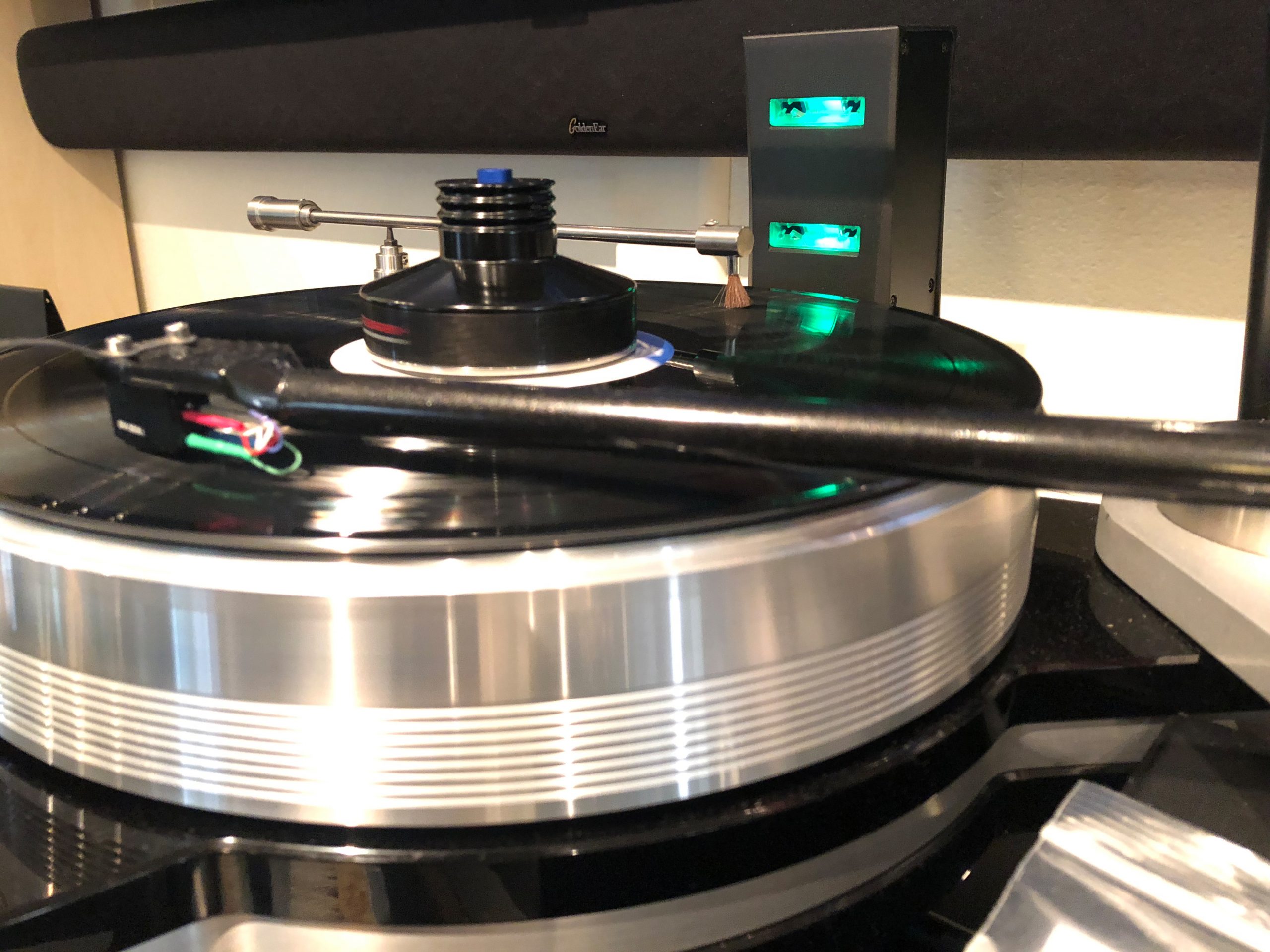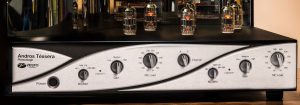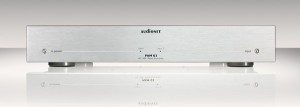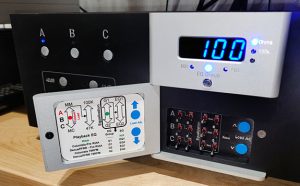"From my cold, dead hands!" - Charlton Heston, describing the only way anyone would be able to take away his guns. I'll state right up front that after a month in my reference system that's exactly how I feel about the Zesto Andros Allasso step up transformer. In fact I was completely smitten with this little sonic marvel in a matter of hours, we bonded that quickly.
Historically step up transformers have come with only one fixed gain and loading setting. This meant you either needed to purchase a SUT compatible with your cartridge, or a cartridge compatible with your SUT. Once you invested in said SUT, you were locked into a cartridge compatible with those gain and loading settings if you wanted to continue using that SUT. This constraint and lack of flexibility has long been a downside for anyone considering a step up transformer for long term use.
A Game Changer
The Zesto Andros Allasso changes all that as a first of its kind step up transformer designed specifically to be compatible with virtually any moving coil cartridge. With a choice of 4 gain settings from 12db to 22db, 10 loading settings, and a switch for either stereo or mono moving coil cartridges, the Allasso offers up to 40 possible combinations for each, more than enough to address the settings necessary for any cartridge now or in the future. That makes it a true game changer. Settings can be easily adjusted via two dials on the front of the Allasso, and made on the fly, without needing to mute the signal, allowing real time monitoring. On the back you'll find inputs for balanced XLR, single ended RCA, and left and right channel ground lift switches. The Allasso removes the traditional joined at the hip SUT/cartridge handcuffs, replacing them with maximum cartridge flexibility and a future proof product users can grow into instead of grow out of. Because of this, it's arguably the last SUT you'll ever need.
The mono switch is also unique, designed specifically to defeat issues with mono cartridge hum. This is achieved via a clever design which takes the left mono input and sends it to both outputs, no more hinky Y adapters!
How SUTs Work
Step up transformers are fascinating, mysterious devices capable of amplifying the signal from a moving coil cartridge passively without the use of any mains power, unlike their powered phono stage counterparts. Because there is no mains power involved, the amplified signal created by a SUT is extremely clean and quiet. How do SUTs achieve this feat of sonic black magic? The simplified explanation is a combination of physics, math, metal, and wire used to create transformers which amplify signal, these are the beating heart of the step up transformer. In simple terms, if you take a piece of metal and wind 10 turns of wire around it, you have what is known as a primary. Wind another 100 turns of wire around that same piece of metal and you then have a secondary, together these form the transformer(s) used to amplify the signal. The primary and secondary windings create the gain ratio a step up transformer uses to amplify a moving coil cartridge's signal. Using the 1 to 10 example above, if you input 1 volt into the primary turns, which is 10 turns of wire, you would get 10 volts out of the secondary (which is 100 turns of wire), this is due to the ratio between each. In other words, when you've got 10 turns of wire on the primary and 100 turns of wire on the secondary, you have a 1:10 transformer. Ratios will differ from SUT to SUT, but that's how gain is achieved.
While there is no mains power involved, a cartridge is an electrical generator which produces a voltage and a current which is fed into the step up transformer, this is where the SUT draws its power. The step up transformer functions as a multiplier for that signal. Again with a 1:10 transformer 1 volt in yields 10 volts out, the critical point being that while it multiplies the signal it doesn't change its power. In other words the amount of power generated by the cartridge doesn't change, the current times the voltage creates a wattage which is the power. The power coming out of the cartridge is converted. Instead of the higher current, lower voltage signal input, you end up with a higher voltage, lower current signal output. It is a still relatively the same power. This is essentially how a SUT operates.
The next piece of the SUT puzzle is loading, which works via the secondary windings on the transformer and serves as a regulator for the dynamics produced by the cartridge. Loading is used to find the sweet spot for the cartridge by not over dampening, bogging it down dynamically or conversely allowing it to become overloaded with too little dampening, hence the name "load." You can think of loading like the shock absorbers on a car. Without them your car would bounce around uncontrollably, adjusted too tightly and you'd feel every bump on the road. Loading is a dampener which controls how hard the stylus, coil, and cantilever need to work to produce electricity.
When using a step up transformer and moving coil cartridge your tone arm's interconnects are plugged into the SUT's input terminals, and the step up transformer is in turn connected to the moving magnet input section of your phono stage a via second second set of interconnects. The moving magnet input section is used because of the increase in gain and the impedances. A typical moving magnet input is 47k, at 200pF, depending on the phono stage, step up transformers are designed go into that. Most phono stages are around 4 to 5 mV in, which is the range that works for step up transformers. The big take away is when using a SUT and moving coil cartridge you use the moving magnet input section of your phono stage.
Gain vs Loading
Gain strictly increases output voltage, aka volume. That said, gain and loading are interrelated, working in tandem, change one and the other is affected. This why the Allasso's 16 different settings can be used to create 40 different loading and gain combinations for both stereo and mono cartridges. With the Allasso, the lower the number on the loading dial the greater the load, the less volume and the more dampened the dynamics. Using less loading, a higher number on the loading dial, produces more volume and livelier dynamics. Simple yet powerful flexibility!
George Counnas, Zesto owner and designer of the Allasso, recommends finding a good starting point for your cartridge, for example a 1:8 gain ratio with a load setting of 5, and then working from there by ear. A small laminated card included with every Allasso provides suggested starting points for different cartridges. Once this is set, George advises using the gain and loading controls to find the sweet spot for your particular cartridge and phono stage combination based on what you're hearing, your preferred degree of dynamics, and what sounds best for your system. This first of its kind flexibility permits cartridges to be fine tuned on the fly not only for your particular system configuration, i.e. phono stage, speakers, room acoustics, and preferred level of dynamics, but also on a per record basis as desired.
Case in point Simon and Garfunkel's Bridge Over Troubled Water, an album with music I love but mastering I don't. I've always found it annoyingly bright in spots. Even my Mobile Fidelity One Step pressing suffers from this top end aggression, less so but it's still there. With the Allasso's flexible controls, taking the edge off was as easy as a counterclockwise turn of the loading knob to dial in a little more dampening and slightly compress the dynamics. To be clear, you're not controlling individual frequencies, dynamics are increased or decreased globally. There are no correct or incorrect settings, it's all based on what you're hearing. This depends on a host of variables such as your system, room, the kind of music you like to listen to, and your preferred level of dynamics. If you lean toward a livelier sound you simply dial in less loading. If your system is prone to inducing listener fatigue, perhaps a more compressed, subdued sound is a better fit, simply back off the dynamics by increasing the loading. It all boils down to personal preference and individual system considerations. This fine tuning flexibility is unique among SUTs sets the Allasso apart.
What distinguishes one SUT from another?
Though all SUTS essentially work the same way, not all are created equally. What you're looking for in a good step up transformer is a combination of increased gain, heightened dynamics, and resolution lacking an analytical sound, a presentation ideally neutral and absent of coloration, with a natural, realistic, musical sound. A hard combination to achieve but one the Allasso pulls off with ease and grace. Doing so involves myriad factors such as the transformers chosen for the design, their sonic characteristics or the lack thereof, and the winding ratio employed for gain. While Zesto keeps information regarding the transformers they use in the Allasso close to the vest, they will divulge that they're the same as those used in their top of the range Tessara and midrange Deluxe Phono Stages. What I can tell you from personal experience is that the Allasso sounds shockingly good! Read on for more on that.
Sound Impressions
The Allasso Step-Up Transformer is another in a long line of system tweaks I didn't realize how much I needed until I had it in my system. Can you relate? Another veil lifted, another level of unexpected performance achieved, you know the drill. Designed specifically to squeeze every last drop of performance out of your cartridge, the Allasso takes all of its signal, works its magic and feeds it directly into your phono stage. It's this transfer of signal/music between your cartridge and the Allasso that allows all of the musical information from your cartridge to reach your phono stage, essentially it's your cartridge on steroids. I had heard good things about the Allasso from owners on social media and industry friends, so I expected a positive result. However, what I heard when I added the Allasso to my system frankly floored me and quickly exceeded all my expectations.
Zesto explains the Allasso's mission is turning a good phono stage and cartridge into a great phono stage and cartridge, and that's exactly what I experienced. Therefore, a good phono stage is a prerequisite foundation for optimal performance. The Allasso played perfectly with the Herron VTPH-2A vacuum tube phono preamplifier in my current system. Zesto is providing their Andros 1.2 phono stage for review in a few weeks. It will be interesting to hear how it differs from the Herron when paired with the Allasso.
Using a VPI Avenger turntable and Dynavector 20X2L 0.3mV moving coil cartridge connected to the Allasso, in turn fed into the moving magnet section of the Herron, both via ANTICABLES Level 6.2 ABSOLUTE Signature RCA analog interconnects, the change was immediate and palpable, akin to a light switch being flipped. The Allasso delivered demonstrably increased resolution without a hint of the analytical harshness I've experienced with past SUTs. Dynamics were wide and expansive, greatly enhanced over those absent the Allasso. Midrange crystal clear and delineated with increased air and extension on a top end sans aggression, and a much deeper, bottom end that had blossomed with additional heft, articulation and weight. The Allasso's "sound" is natural, flowing, and musical. All signature Zesto characteristics I'm told by friend and Zesto dealer Jeff Harris of Reference Analog. I lean toward the lively end of the presentation spectrum so after experimenting I settled on a 1:12 gain setting of 22dB and loading at 5 or 6, 80, or 100 ohms respectively, depending on what I'm listening to. The Allasso treated all genres with equal aplomb across the board wiping away a layer of sonic grime and bringing me that much closer to the music. It beautifully handled the rock, jazz, classical, opera, pop vocals, reggae, electronica, and the hip hop I used to gauge its range. With the Allasso music simply sounds more dynamic, clearer, and more musical…better!
Magnetic Interference
Despite its attractive well shielded casework, the Allasso, like other SUTs, is sensitive to interference from any magnetic fields around it. For this reason you'll want to take special care when placing it into your rack relative to other components. I first planned to place the Allasso between my VPI Analog Drive System (ADS) and Herron VTPH-2A vacuum tube phono preamplifier, with ample space between each. This was a big fail! The Allasso was not a happy camper in that position, the level of interference from the components left and right was not only surprising but wholly unacceptable. Next, after trying a few different locations, the sweet spot for placement ended up being right next to my turntable. The Allasso fits like a glove under the arm board of my VPI Avenger with its Reference Feet installed. This is where it now lives. The interference is gone and the bonus is the top of the Allasso is a great platform for my Levin record cleaning brush or VPI HRX center weight!
Who Needs The Allasso?
Anyone looking to get more signal performance from either a low or high output moving coil cartridge. Anyone who wants to add a second moving coil cartridge, but only has one moving coil input on their phono stage. Maybe you have a great phono stage but you've upgraded to a cartridge that doesn't play well with it, enter the Allasso. Phono stages are designed in large part with a broad spectrum of moving coil cartridges in mind. The big advantage of the Allasso, in addition to its amazing sonics which are not to be underestimated, is its flexibility to dial in settings specifically tailored to your cartridge/phono stage needs, without the downside of being locked into a narrow range of cartridges moving forward. Because of this, it's not hype to say that if you like what you hear with Allasso as much as I do it might just be the last step up transformer you'll ever need.
Andros Allasso Step-Up Transformer
Retail: $2995
Zesto Audio




